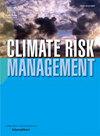Understanding drought adaptation mechanisms from a gender perspective in Modogashe Ward, Kenya
IF 4.8
2区 环境科学与生态学
Q1 ENVIRONMENTAL SCIENCES
引用次数: 0
Abstract
Droughts have severely affected the pastoral production system resulting in hunger, massive loss of livestock, acute water shortages, and drought-related conflicts. This study aimed to understand the drought adaptive mechanisms from a gender perspective in Modogashe Ward, Kenya. To achieve this, the study investigated the impacts of droughts and the various ways in which men and women cope and adapt to the impacts. Due to the homogeneousness in sociocultural and economic activities in the Ward data was obtained from 60 respondents comprising 30 males and 30 females through a stratified random sampling method. One respondent, either the husband or wife, was chosen per household. Both men and women rely on pastoralism as the main source of livelihood. Thus, the impacts and adaptation mechanisms were similar for both genders. However, due to the attachment of men to livestock, the impacts and adaptation mechanisms revolved around environmental factors while those of women revolved around the provision of household basic needs. Furthermore, the study area had limited adaptation mechanisms options resulting in similar coping and adaptation strategies among men and women but with minor variations in the preferred strategies. The variations in the preferred strategies were a reflection of the existing gender roles within the social construct of the community. Men were inclined toward measures that promote livestock keeping while women preferred measures that enhanced the provision of household basic needs. The findings from this study highlight the significant role of gender dimensions driven by the local socio-cultural settings in influencing the uptake of drought adaptation practices and strategies among communities.
求助全文
约1分钟内获得全文
求助全文
来源期刊

Climate Risk Management
Earth and Planetary Sciences-Atmospheric Science
CiteScore
8.20
自引率
4.50%
发文量
76
审稿时长
30 weeks
期刊介绍:
Climate Risk Management publishes original scientific contributions, state-of-the-art reviews and reports of practical experience on the use of knowledge and information regarding the consequences of climate variability and climate change in decision and policy making on climate change responses from the near- to long-term.
The concept of climate risk management refers to activities and methods that are used by individuals, organizations, and institutions to facilitate climate-resilient decision-making. Its objective is to promote sustainable development by maximizing the beneficial impacts of climate change responses and minimizing negative impacts across the full spectrum of geographies and sectors that are potentially affected by the changing climate.
 求助内容:
求助内容: 应助结果提醒方式:
应助结果提醒方式:


